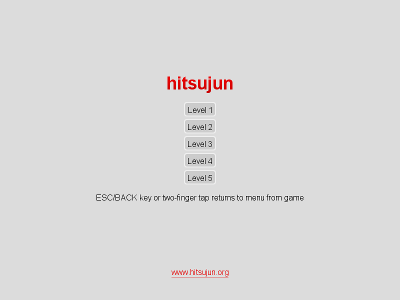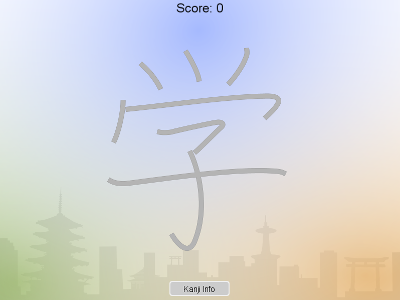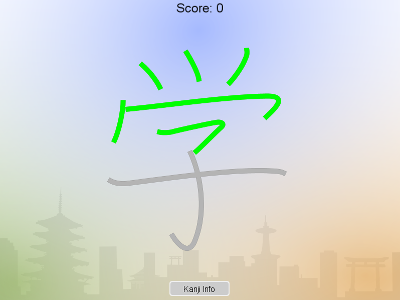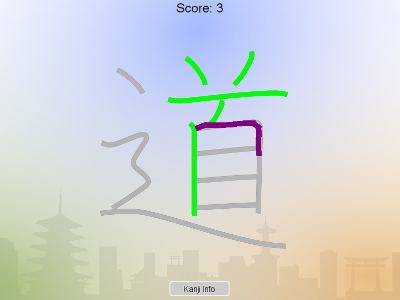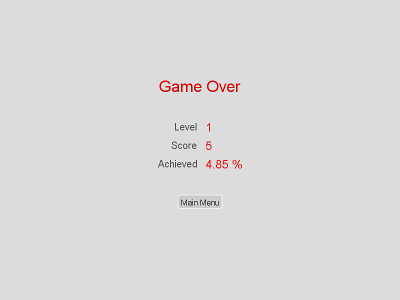Hitsujun
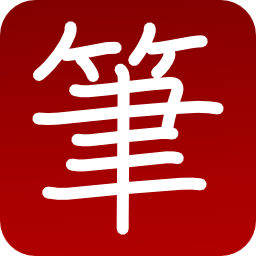
Hitsujun is a single-player educative game which requires the participant to draw1 a randomly selected kanji over its template. The order of the strokes as well as the direction in which each stroke is drawn matter. The main purpose is to learn Japanese kanji.
The set of 6,393 kanji2 is partitioned into 5 levels. The levels 1 to 4 pick out their kanji in the JLPT’s list of kanji as defined prior to 20103. Level 1 chooses in the JLPT N4’s list, level 2 in the JLPT N3’s list and so forth… For each kanji covered by the KanjiVG project, we rely on the KANJIDIC2 dictionary file to determine its JLPT occurrence, if any. The level 5 uses the list of the 4,163 remaining kanji that are presumably outside the scope of the JLPT.
Each kanji comes with some basics information, readings (on-yomi, kun-yomi), definitions and number of strokes.
Online Version (HTML5)
The app is available at kanji-hitsujun.appspot.com. Basically all modern browsers that are reasonably HTML5 compliant should work (such as, e.g., any recent versions of Chrome, Safari, Firefox, Internet Explorer…).
Mobile Version
Android
You can get it either on Google Play or on Amazon Appstore.
iOs
May come… eventually, but hindered by cost related issues… Meanwhile you can use the add to home screen ( ) feature of Safari.
) feature of Safari.
Desktop Version
| OS | Version | Description | Release Date | Size | Download |
|---|---|---|---|---|---|
| Mac OS X | 1.1 | App Bundle | 23 June 2014 | 73.10 MB | dmg |
| Windows (x64) | 1.1 | Installer | 23 June 2014 | 72.60 MB | msi |
| Windows (x64) | 1.1 | Installer | 23 June 2014 | 53.50 MB | exe |
| Windows (x86) | 1.1 | Installer | 23 June 2014 | 71.50 MB | msi |
| Windows (x86) | 1.1 | Installer | 23 June 2014 | 52.40 MB | exe |
| All* | 1.1 | Executable Jar | 23 June 2014 | 14.30 MB | jar |
The installers (Windows) and the app bundle (Mac OS) are coming with their own embedded JRE; therefore, there is no need to install any additional components (i.e., the JRE 7).
In order to use the jar file, after making sure that your machine has the Java SE 7 JRE installed (e.g., by using the command java -version), just double click on the jar file; or, alternatively, use the command:
Note: older versions can be downloaded here.
License and Source Code
© 2014 Loic Merckel, Apache v2 licensed. The source code is available on GitHub.
Screenshot
Disclaimer
This software is currently being actively developed. The current version 1.1, as well as all the anterior versions, may bear imperfections and may lack stability. We encourage the users to carefully read the license, and in particular the point 7.
Should you find some issues, please report them using the dedicated GitHub issue tracker.
Note that this issue tracker can also be used to request new features you may need.
Acknowledgement
The KanjiVG is copyright Ulrich Apel and released under the Creative Commons Attribution-Share Alike 3.0 license.
This application relies on the KANJIDIC2 dictionary file, which is the property of the Electronic Dictionary Research and Development Group, and are used in conformance with the Group’s licence.
-
to write a kanji might be more correct… ↩
-
these are the kanji currently occurring in both the KanjiVG project and the KANJIDIC2 dictionary file (as of June 2014); i.e., if a kanji is found in the KanjiVG list, but not in the KANJIDIC2 list, then it is ignored, and vice versa. ↩
-
regarding the JLPT level, after the JLPT revision in 2010, the “Test Content Specifications” are no longer officially available (see the FAQ of the JLPT official website). Furthermore, a new level has been introduced, widening the range from N4-N1 to N5-N1. The encompassment of the test in its globality should have remained unchanged, though. The former level N2 has been somehow splitted into the new levels N2 and N3, the former levels N3 and N4 have become the new level N4 and N5, respectively. ↩
